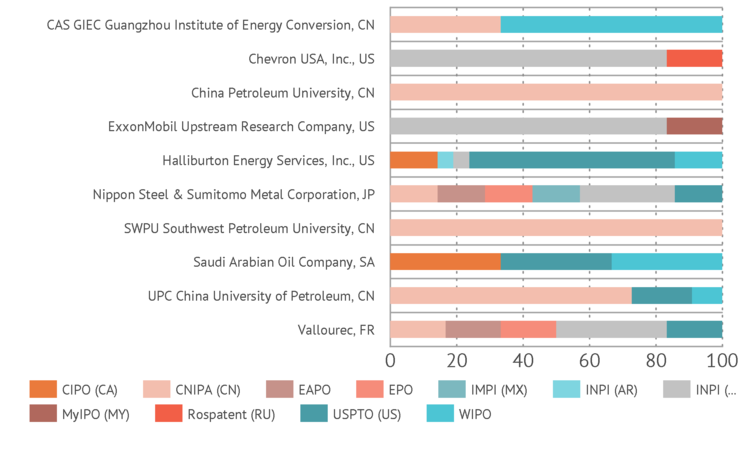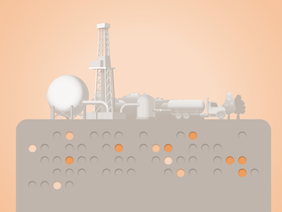In the previous comments, which included an analysis of patent applications registered in 2017 around the world and related to the field of methane extraction from gas hydrate formations, mainly statistical data was provided concerning the distribution of documents by patent offices of the world, as well as by unified groups of problems and elements of technological processes. This paper discloses the data concerning the main applicants from the 72 mentioned in the patent documents whose patent applications were published in 2017 in various patent offices of the world.
The table below represents general information on the top 10 applicants:
| Status | Country | Name | Average, Rate | Total, 2017 |
|---|---|---|---|---|
| Company | US | Halliburton Energy Services, Inc. | 12.2 | 21 |
| Organization | CN | SWPU Southwest Petroleum University | 11.4 | 12 |
| Organization | CN | China Petroleum University | 11.6 | 11 |
| Organization | CN | UPC China University of Petroleum | 10.7 | 11 |
| Company | JP | Nippon Steel & Sumitomo Metal Corporation | 8.4 | 7 |
| Organization | CN | CAS GIEC Guangzhou Institute of Energy Conversion | 11.8 | 6 |
| Company | US | Chevron USA, Inc. | 12.5 | 6 |
| Company | US | ExxonMobil Upstream Research Company | 13.8 | 6 |
| Company | SA | Saudi Arabian Oil Company | 10.3 | 6 |
| Company | FR | Vallourec | 8.7 | 6 |
Representatives of China and the USA were the most active among the top 10 applicants. American company Halliburton Energy Services, Inc. registered the highest number of patent applications. Chinese applicants are represented by various educational and research organizations. In addition to the aforementioned, the top 10 list of applicants includes companies from Japan, Saudi Arabia and France.
The US companies have the highest estimated values of average bibliographic rating of patent documents – from Halliburton Energy Services, Inc with 12.2 to ExxonMobil with 13.8.
Technological interests of the top 10 applicants
A-Activation; DCG-Drilling or capture in general; E-Exploration; IS-Infrastructure & security; TT-Treatment & transportation;
UGC-Underground drilling or extraction; UWC-Underwater drilling or capture
Patent applications of American companies ExxonMobil and Chevron USA, Inc. are predominantly dedicated to the issues of exploration of gas hydrate formations. Japanese Nippon Steel & Sumitomo Metal Corporation and French Vallourec disclosed novel technical solutions related to the aspects of processing and transportation of methane extracted from gas hydrates. Inventors from Halliburton Energy Services, Inc.; SWPU Southwest Petroleum University and China Petroleum University demonstrated more diverse interests; however, issues concerning the activation of gas hydrate formations prevailed in their documents.
Distribution of patent applications from the leading applicants by patent offices of the world
China Petroleum University is the only applicant that filed its applications in one patent office (its own country). Halliburton Energy Services, Inc.; Nippon Steel & Sumitomo Metal Corporation and Vallourec have the most extensive representation in different offices of the world. USPTO is the most popular patent office among non-residents.
All of the aforementioned companies disclosed different devices and methods for the development of technological processes in their inventions. Only three companies have proposals on novel compositions in their patent application portfolio – Halliburton Energy Services, Inc.; China Petroleum University and Saudi Arabian Oil Company.
The most popular problems that the proposed technical solutions aimed to solve are: Halliburton Energy Services, Inc. – LEEF (Low efficiency of exploration and forecasting), LEPP (Low efficiency of primary processes) and NEP (Natural environment protection measures); Nippon Steel & Sumitomo Metal Corporation and Vallourec – HOM (High OPEX/Maintenance); ExxonMobil – HCE (High CAPEX/Exploration) and LEEF; Chevron USA – LEEF; Saudi Arabian Oil Company – HAPC (High additional production costs) and LEPP. The degree of diversity of the problems mentioned in the patent documents of the remaining participants was considerably higher.
More detailed information on the methodology as well as on the results of patent researches in the most important fields of contemporary energy industry can be found at www.aenert.com
